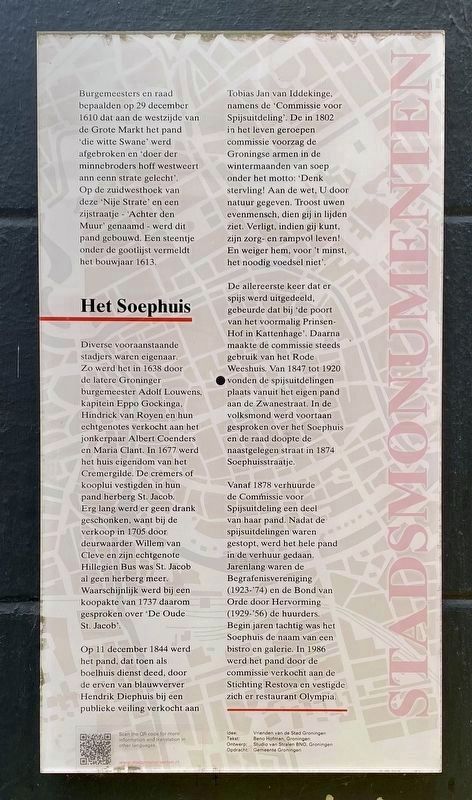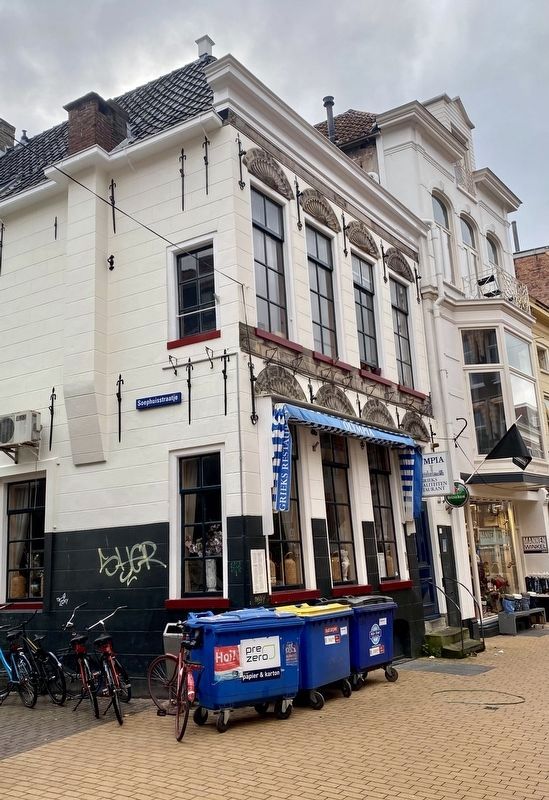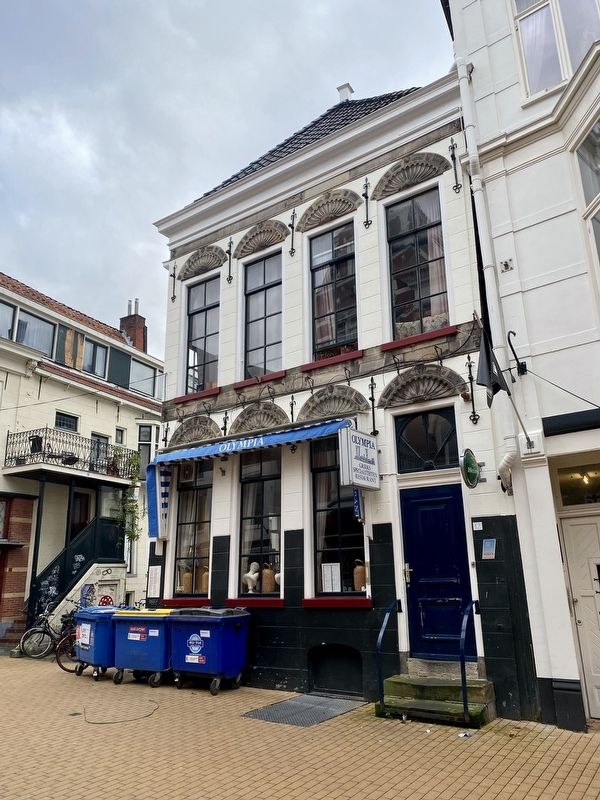Groningen, Netherlands — Northwestern Europe
Het Soephuis / The Soup House
— Stadsmonumenten —
Burgemeesters en raad bepaalden op 29 december 1610 dat aan de westzijde van de Grote Markt het pand ‘die witte Swane’ werd afgebroken en ‘doer der minnebroders hoff westweert ann eenn strate gelecht’. Op de zuidwesthoek van deze ‘Nije Strate’ en een zijstraatje – ‘Achter den Muur’ – werd dit pand gebouwd. Een steentje onder de gootlijst vermeldt het bouwjaar 1613.
Diverse vooraanstaande stadjers waren eigenaar. Zo werd het in 1638 door de latere Groninger burgemeester Adolf Louwen, kapitein Eppo Gockinga, Hindrick van Royen en hun echtgenotes verkocht aan het jonkerpaar Albert Coenders en Maria Clant. in 1677 werd het huis eigendom van het Cremergilde. De cremers of kooplui vestigden in hun pand herberg St. Jacob. Erg lang werd er geen drank geschonken, want bij de verkoop in 1705 door deurwaarder Willem van Cleve en zijn echtgenote Hillegien Bus was St. Jacob al geen herberg meer. Waarschijnlijk werd bij een koopakte van 1737 daarom gesproken over ‘De Oude St. Jacob’.
Op 11 december 1844 werd het pand, dat toen als boelhuis dienstdeed, door de erven van blauwverver Hendrik Diephuis bij een publieke veiling verkocht aan Tobias Jan van Iddekinge, namens de ‘Commissie voor Spijsuitdeling’. De in 1802 in het leven geroepen commissie voorzag de Groningse armen in de wintermaanden van soep onder het motto: ‘Denk stervling! Aan de wet, U door natuur gegeven. Troost uwen evenmensch, dien gij in leiden ziet, Verligt, indien gij kunt, zijn zorg- en rampvol leven! En weiger hem, voor ’t minst, het noodig voedsel niet’.
De allereerste keer dat er spijs werd uitgedeeld, gebeurde dat bij ‘de poort van het voormalig Prinsenhof in Kattenhage’. Daarna maakte de commissie steeds gebruik van het Rode Weeshuis. Van 1847 tot 1920 vonden de spijsuitdelingen plaats vanuit het eigen pand aan de Zwanestraat. In de volksmond werd voortaan gesproken over het Soephuis en de raad doopte de naastgelegen straat in 1874 Soephuisstraatje.
Vanaf 1878 verhuurde de Commissie voor Spijsuitdeling een deel van haar pand. Nadat de spijsuitdelingen waren gestopt, werd het hele pand in de verhuur gedaan. Jarenlang waren de Begrafenisvereniging (1923-’74) en de Bond van Orde door Hervorming (1929-’56) de huurders. Begin jaren tachtig was het Soephuis de naam van een bistro en galerie. In 1986 werd het pand door de commissie verkocht aan de Stichting Restova en vestigde zich er restaurant Olympia.
On December 29th, 1610, mayors
and council have determined that on the west-side of the main square, "De Grote Markt", the premise "die witte Swane" was demolished and "doer der minnebroders hoff westweert ann eenn strate gelecht". On the southwest corner of this "Nije Strate" and a side alley – “Achter den Muur” – this house has been built. A brick beneath the fascia mentions the building year of 1613.
Several influential citizens of Groningen have been owners of the premise. In 1638, the later mayor of Groningen, Adolf Louwen, Capitan Eppo Gocking, Hindrick van Royen and their spouses sold the building to the young couple Albert Coenders and Maria Clant. In 1677, the house became a property of the Cremerguild. The "cremers" or merchants established the St. Jacob lodge in the property. For a long period no alcohol has been poured, and after the premise was sold by bailiff Willem van Cleve and his spouse Hillegien Bus in 1705, St. Jacob did not function as a Lodge anymore. This is probably the reason why in the purchase deed of 1737 “The old St. Jacob” was mentioned.
On December 11, 1844, the property, which at that point was used as a house lot, was sold at a public auction by the heirs of painter Hendrik Diephuis, to Tobias Jan van Iddekinge, in name of the “commission of food distribution”. The in 1802 established commission, provided poor people of Groningen with soup during the winter months, under the philosophy: “Think, mortal! By law, given you by nature. Comfort your fellow citizens, who you see suffering, enlighten, if you shall be able, his care and disastrous life! Deny him, for the less, not the necessary food”
The first time food has been shared, it occurred at "The gate of the previous Prinsenhof in Kattenhage". Afterward, the commission used "het Rode Weeshuis" (an orphanage). From 1847 until 1920 the food sharing took place in their own premise located in the Zwanestraat. From that day on, the citizens spoke about “het Soephuis” and the counsel named the adjacent street in 1874 Soephuisstraatje.
From 1878 onwards, the commission of food distribution rented out a part of their property. After the distribution of food has been stopped, the whole property has been placed for rent. For years, the property has been rented by the funeral association (1923-’74) and the Bond of Order by Reform (1929-’56). In the early eighties, “het Soephuis” was the name of a bistro and galleria. In 1986, the property was sold by the commission to the Restova foundation and restaurant Olympia was established.
Erected by Gemeente Groningen. (Marker Number 45.)
Topics and series. This historical marker is listed in these topic lists: Charity & Public Work • Industry & Commerce. In addition, it is included in the Groningen Stadsmonumenten series list. A significant historical date for this entry is December 29, 1610.
Location. 53° 13.089′ N, 6° 33.858′ E. Marker is in Groningen. Marker is on Soephuisstraatje, on the left when traveling north. Touch for map. Marker is in this post office area: Groningen 9712 GB, Netherlands. Touch for directions.
Other nearby markers. At least 8 other markers are within walking distance of this marker. Chez Dicque (about 90 meters away, measured in a direct line); Vismarkt 40 (about 120 meters away); Carl von Rabenhaupt (about 120 meters away); Goudkantoor (about 150 meters away); Korenbeurs / Grain Exchange (about 150 meters away); Huis met de Dertien Tempels / House with the Thirteen Temples (about 150 meters away); Vismarkt 56 (about 150 meters away); Vereeniging van Groningen Handelaren / Groningen Merchants Association (1847 - 1992) (about 150 meters away). Touch for a list and map of all markers in Groningen.
Credits. This page was last revised on December 31, 2023. It was originally submitted on December 30, 2022, by Andrew Ruppenstein of Lamorinda, California. This page has been viewed 85 times since then and 11 times this year. Photos: 1, 2, 3. submitted on December 30, 2022, by Andrew Ruppenstein of Lamorinda, California.


